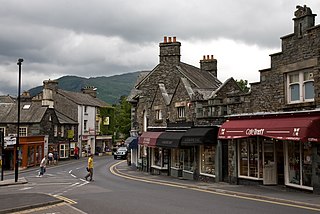
Ambleside is a town and former civil parish in the Westmorland and Furness district of Cumbria, England. Within the boundaries of the historic county of Westmorland and located in the Lake District National Park, the town sits at the head of Windermere, England's largest natural lake. In 2020 it had an estimated population of 2,596.

Matlock is the county town of Derbyshire, England. It is in the south-eastern part of the Peak District, with the National Park directly to the west. The spa resort of Matlock Bath is immediately south of the town as well as Cromford lying further south still. The civil parish of Matlock Town had a population in the 2021 UK census of 10,000.

Keswick is a market town and civil parish in the Cumberland unitary authority area of Cumbria, England. Historically, until 1974, it was part of the county of Cumberland. It lies within the Lake District National Park, Keswick is just north of Derwentwater and is four miles from Bassenthwaite Lake. The parish had a population of 5,243 at the 2011 census.
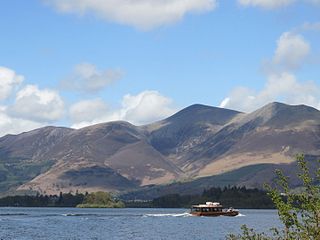
Skiddaw is a mountain in the Lake District National Park in England. Its 931-metre (3,054 ft) summit is the sixth-highest in England. It lies just north of the town of Keswick, Cumbria, and dominates the skyline in this part of the northern lakes. It is the simplest of the Lake District mountains of this height to ascend and, as such, many walking guides recommend it to the occasional walker wishing to climb a mountain. This is the first summit of the fell running challenge known as the Bob Graham Round when undertaken in a clockwise direction.

Hostelling International (HI) is a non-governmental, not-for-profit organisation working with UNESCO and the World Tourism Organisation UNWTO. Formerly known as International Youth Hostel Federation, Hostelling International has 60 member associations operating over 2,650 hostels around the world.

Borrowdale is a valley and civil parish in the English Lake District in Cumberland, England. It is in the ceremonial county of Cumbria, and is sometimes referred to as Cumberland Borrowdale to distinguish it from another Borrowdale in the historic county of Westmorland.
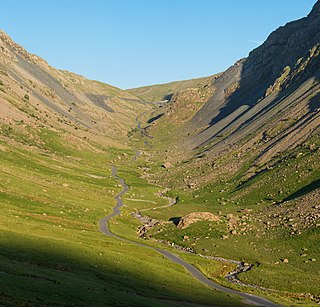
Honister Pass is a mountain pass in the Lake District in Cumbria, England. It is located on the B5289 road, linking Seatoller, in the valley of Borrowdale, to Gatesgarth at the southern end of Buttermere. The pass reaches an elevation of 1,167 feet (356 m), making it one of the highest in the region, and also one of the steepest, with gradients of up to 1-in-4 (25%). The saddle at the watershed is known as Honister Hause, using the Cumbrian word hause for such a feature.

Above Derwent is a civil parish in Cumbria, England, to the west of Derwentwater and Keswick. It lies entirely within the Lake District National Park.
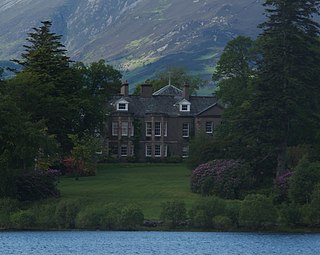
Derwent Island House is a Grade II listed 18th-century Italianate house situated on the seven-acre (three-hectare) Derwent Island, Derwent Water, Keswick, Cumbria, and in the ownership of the National Trust. It is leased as a private home, but is open to the public five days a year. The interior is classical in style.

Wilderhope Manor is a 16th-century manor house in the care of the National Trust. It is located on Wenlock Edge 7 miles (11 km) south west of Much Wenlock in Shropshire, England. The manor is a Grade I listed building and since 1937 has been used as a youth hostel.

The Jersey Accommodation and Activity Centre is a building just north of Gorey in the parish of Saint Martin, Jersey, in the Channel Islands. It was formerly known as the Industrial School, the Jersey Home for Boys, and Haut de la Garenne. Its previous uses have included being an industrial school, a children's home, a military signal station, a television filming location, and a youth hostel. In 2008 it became the focus of the largest investigation into child abuse ever conducted in Jersey.

Lodore Falls is a waterfall in Cumbria, England, close to Derwentwater and downstream from Watendlath. The falls are located on the beck that flows from Watendlath Tarn, and tumble more than 100 feet (30 m) over a steep cascade into the Borrowdale Valley. Although it is spectacular in the rainy season, it can dry to a trickle in the summer.

The Youth Hostels Association is a charitable organisation, registered with the Charity Commission, providing youth hostel accommodation in England and Wales. It is a member of the Hostelling International federation.

YHA Ltd, trading as YHA Australia, is a not-for-profit of members trading corporation providing hostel and other accommodation, travel and associated service in Australia. It is a member organisation of Hostelling International.
The Youth Hostel Association of New Zealand is a youth hostelling association in New Zealand. As of 2022, it comprises 16 privately owned associate backpacker hostels—8 in the North Island, and 9 in the South Island. All properties are franchise or associate partners.
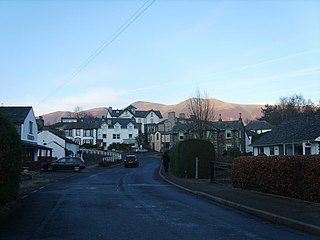
Portinscale is a village in Cumbria, England, close to the western shore of Derwentwater in the Lake District National Park 1+1⁄2 miles from Keswick.
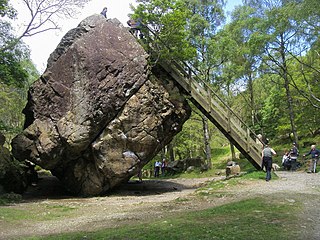
The Bowder Stone is a large andesite lava boulder, that fell 200 metres (660 ft) from the Bowder Crag on Kings How between 13,500 and 10,000 years ago. The stone is situated in Borrowdale, Cumbria, England, at grid reference NY25401639. It is estimated to weigh around 2000 tons and is about 30 feet (9.1 m) high, 50 feet (15 m) across and 90 feet (27 m) in circumference. There is a staircase allowing visitors to climb to the top, and has been since at least 1890.
Borrowdale is a civil parish in the Borough of Allerdale in Cumbria, England. It contains 39 listed buildings that are recorded in the National Heritage List for England. All the listed buildings are designated at Grade II, the lowest of the three grades, which is applied to "buildings of national importance and special interest". The parish is in the Lake District National Park, and it includes the settlements of Rosthwaite, Stonethwaite, Seathwaite, Seatoller, Grange, and Watendlath. Parts of the parish are agricultural, and much of it consists of fells and mountains. All the listed buildings are in the settlements and the valleys. A high proportion of them are, or originated as, houses, cottages, farmhouses or farm buildings. The other listed buildings are seven bridges, a former corn mill, a war memorial, and two telephone kiosks.

Cliffe Park Hall is a country house near Rudyard in Staffordshire, England. During its 200-year history, it has been a private residence, a golf club house and a youth hostel. The hall is a Grade II listed building.


















